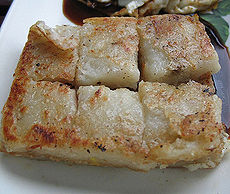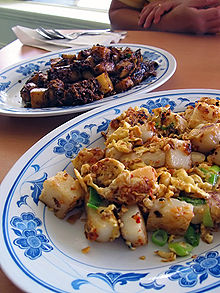- Turnip cake
-
Turnip cake 
Origin Alternative name(s) daikon cake, radish cake Place of origin Southern China Region or state Chinese-speaking areas Dish details Course served Yum cha Main ingredient(s) shredded radish (typically Chinese radish or daikon), plain rice flour Variations Fried and steamed Turnip cake Traditional Chinese 蘿蔔糕 Simplified Chinese 萝卜糕 Hanyu Pinyin luóbo gāo Cantonese Jyutping lo4 baak6 gou1 Literal meaning daikon cake Transcriptions Mandarin - Hanyu Pinyin luóbo gāo Cantonese (Yue) - Jyutping lo4 baak6 gou1 Alternative Chinese name Chinese 菜頭粿 Transcriptions Min - Hokkien POJ chhài-thâu-kué, chhài-thâu-ké Turnip cake is a Chinese dim sum dish made of shredded radish (typically Chinese radish or daikon) and plain rice flour. The less commonly-used daikon cake is a more accurate name, in that Western-style turnips are not used in the dish; it is sometimes also referred to as radish cake. It is commonly served in Cantonese yum cha and is usually cut into square-shaped slices and sometimes pan-fried before serving. Each pan-fried cake has a thin crunchy layer on the outside from frying, and soft on the inside. The non-fried version is soft overall. It is one of the standard dishes found in the dim sum cuisine of Hong Kong, China, and overseas Chinatown restaurants. It is also commonly eaten during Chinese New Year, since radish (菜頭, chhài-thâu) is a homophone for "good fortune" (好彩頭, ho-chhài-thâu) in Hokkien.[1]
Contents
Preparation
To prepare a turnip cake, Chinese radish (similar to daikon) are first shredded. Chinese radish, either the white-and-green variety or the all-white variety, is one of the key ingredients since it makes up a large portion of the cake. The other key ingredients are water and rice flour. Corn starch is sometimes added as it aids in binding the cake together, especially when a large number of additional ingedients (see list below) are added. The ingredients are stirred together until combined.
Additional ingredients that provide umami flavouring can be also added. They include chopped-up pieces of:
- Reconstituted dried shrimp
- Reconstituted dried Shiitake
- Chinese sausage
- Jinhua ham
- Shredded carrots
These flavoring ingredients may first be stir-fried before being added to the radish and flour/starch mixture. Somewhat more luxurious cakes will add larger amounts of these ingredients directly to the mixture. Cheaper variants, especially those sold in dim sum restaurants will often just have a sprinkling on the top, to keep costs down.
This combined mixture is then poured in a steamer lined with greased aluminum foil or cellophane, and steamed at high heat for 40 to 60 minutes until it solidifies into a gelatinous mass.
Note that variations for specific tastes do exist omitting some of the ingredients above (for example carrots are rare) and adding others.
For those with allergies to radishes, some recipes substitute turnip for radish.[citation needed] Taro or pumpkin cakes are other variants.
Uses
Although the steamed turnip cake can be consumed straight with soy sauce, they are commonly cooked again to add additional flavors. For instance turnip cake can be sliced into square pieces when cooled and then pan-fried until both sides turn golden. It is served with white pepper, chili sauce, Hoisin sauce and/or oyster sauce on the side, as condiments.
 Turnip cake made into dark (with dark soy and molasses) and light (salt and fish sauce styled Chai tow kway
Turnip cake made into dark (with dark soy and molasses) and light (salt and fish sauce styled Chai tow kway
Turnip cake can also be stir-fried and made into the dish Chai tow kway.
See also
References
- ^ Bartholomew, Ian (24 January 2008). "New Year's Eve dinner: easy as pie". Taipei Times: pp. 13. http://www.taipeitimes.com/News/feat/archives/2008/01/24/2003398676. Retrieved 16 July 2011.
External links
Chinese New Year Topics Chinese dragon · Chinese New Year · CCSTV New Year's Gala · CCTV New Year's Gala · Chinese New Year in Singapore · Chunyun · Lion dance · New Year picture · Red envelope · Reunion dinner · San Francisco Chinese New Year Festival and Parade · Color in Chinese culture · Fireworks · Firecracker · Dragon dance · NianFood Bakkwa · Buddha's delight · Fa gao · Fat choy · Jau gok · Jiaozi · Kralan · Kuih · Lotus seed · Nian gao · Reunion dinner · Spring pancake · Squab (food) · Taro cake · Turnip cake · Yusheng · Melon seed · Mandarin orange · Fish · PineappleCategories:- Dim sum
- Cantonese cuisine
- Chinese New Year foods
Wikimedia Foundation. 2010.
